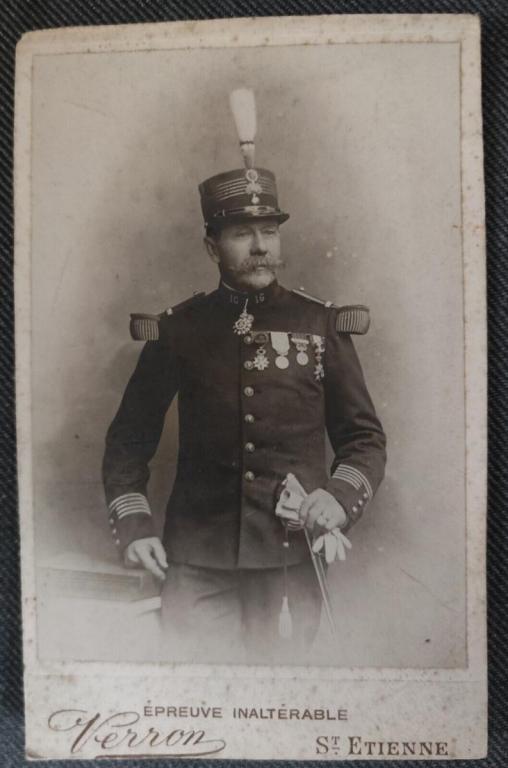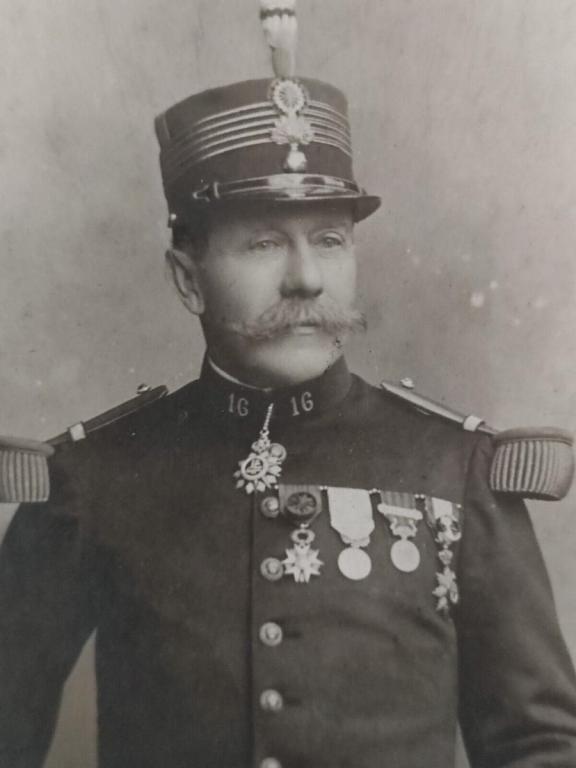-
Posts
3,101 -
Joined
-
Last visited
-
Days Won
6
Content Type
Profiles
Forums
Blogs
Gallery
Events
Store
Everything posted by The Prussian
-
Yes, I´ve found a Schultz with EKII in the 5.Art.Brig. But in ranklist 1872 he ain´t mentioned. Even not in "Departures". There I only found a "Schulz" (without "t"). And I couldn´t find a Schultz of 5th Art in the EKII list! I think there was a mistake made with the name. Schulz or Schultz is a name like Miller or Smith in english-spoken countries. The are "billions" of them in Germany... From the EKII list: Schultz: Nast:
-
Back from work... Well, Sec.Lt. Albert Karl Nast received his EKII in 8th battery/ Festungs-Artillerie-Regiment Nr.5 Sec.Lt. Karl Ludwig Schultz in 4th heavy battery/ Feldart.Rgt.9 FAR9 fought 70/71: Collombey-Nouilly, Gravelotte-St.Privat, Metz, Nouisseville, Toul, Paris, Lessy, Chenegy, Dreux, La Madeleine Bouvet, Bellème, Loigny-Poupry, Orléans, La Motte-Beuvron, Meung, Beaugency-Cravant, Vienne, Oucques, Fréteval, Epuisay, Le Mnas and Orbec. No match with the claps of the officer.
-
Hello! Schultz was commander of Fußart.Rgt.5 between March 19, 1896 and June 16, 1898 and Chef of the "Feldzeugmeisterei" (Ordnance Departement) between April 1, 1898 and April 18, 1900 He became Oberst in April 21, 1898. Major Nast was promoted to Oberstleutnant August 18, 1898. In 1899 he had: RAO4, EK2, and DAK. In 1900 he had KO3 too. You´re right with the star. The photo shows an Oberstleutnant. So I assume, we have Oberstleutnant Nast in 1900. In the autumn-ranklist 1900 he was not mentioned, because he was set to z.D. (to disposition or "on half pay"), and Oberstleutnant Kohlbach to the command of the regiment. Nast was commander of Fußart.Rgt5 between June 16, 1898 and May 22, 1900. We need to know, when he received his KO3. So the photo must had been taken between summer/autumn 1899 and May 22 1900. Maybe it was taken because of the awarding of KO3 or because of his departure
-
Hello! Because he was ill in hospital, I can´t imagine he died because of any war-trouble. Another idea: Young Elsa Meta (last name unknown) lost a close relative in the war (father, brother). Between 1918 and 1934 she´s got married with this Mr. Motschmann and so she changed her last name. That´s why she owned his military papers. Unfortunately we can´t see, WHO died in the war, only the recipient of the cross. BUT maybe we have luck! Elsa Meta is a rare first name. I checked Ancestry with "Elsa Meta" and "Hohenleuben". ONE SINGLE MATCH: Elsa Meta Seidemann (born Oct 11, 1891). Checking the casualty lists, I´ve found five Seidemann from Gera*, who were k.i.a. 1) Friedrich, k.i.a. 1916 (Pionier-Regiment 19) 2) Max, k.i.a. 1918 (no unit) 3) Otto, k.i.a. 1918 (no unit) 4) Paul, k.i.a. 1916 (Leib-Grenadier-Regiment 8 ) 5) Willi, k.i.a. 1915 (Infanterie-Regiment 176) Totally there are 37 k.i.a. Seidemann in the casualty lists. * Hohenleuben belonged to Gera, since 1922 to Greiz. 1840 it had 2103 inhabitans, 1947 only 2512. So around 1900 maybe 2200 (just a guess) Another idea. The mother of Mr. Motschmann received the cross for another killed son and gave it to her daughter-in-law Elsa Meta There are 12 k.i.a. Motschmann in the casualty lists.
-
Hello! That´s strange... I read: "confirmed as pension recipient". I can´t find any wounds. The World War Cross of Honour for Widows and Parents was established on 13 July 1934 at the request of Reich President Paul von Hindenburg together with the two other World War Crosses of Honour. It was the first state honour to commemorate the First World War. The Cross of Honour of the World War was awarded in 3 variants: Cross for Frontline Combatants, Cross for Veterans, Cross for Survivors (widows and parents). However, only one version could be applied for. The cross was issued by the city administration, police authorities or other state authorities. The cross was issued a total of approx. 10,000,000 times in the 3 types and is therefore not rare. Widows and parents of soldiers who died or were missing in war or captivity were considered survivors. Widows were women whose marriage was concluded before 31 December 1918. Parents also included step-parents and adoptive parents. The cross for surviving dependants is the least awarded of the three crosses. The ribbon differs from the ribbon of the other two crosses. His units: 29.12.14: Ersatz-Rekrut, 3.Rekruten-Depot, 1.Ersatz-Bataillon, Inf.Rgt.167 "Nur garnisonsverwendungsfährig" (suitable for garrison use only) 7.9.16-17.9.16: Garnisons-Kompagnie 2, I.Eratz-Bataillon Inf.Rgt.167 17.9.16-26.9.16: ??? hinter der Front 26.9.16-30.1.17: 14./Inf.Rgt.112 30.1.17: 6./Inf.Rgt.112 22.2.17: Hospital (as "ill", not "wounded") 19.4.17: Ersatz-Bataillon, Genesenden-Kompagnie Inf.Rgt.112 15.4.18: discharged to "Landwehr I" as Pensioner and promotion to Gefreiter For me, the award is not justified
-
Many Thanx! But that was not enough for a wound badge...😁 And I have a problem with Minenwerfer-Kompagnie 343. An MWK with that number did not exist! But I´ve got some crazy ideas in my crazy head... The Inf.Rgt.343 was formed by: I.Btl. of Ers.Btl./IR129 II.Btl. of Ers.Btl./IR141 III.Btl. of Ers.Btl./IR175 August 8, 1918 a Minenwerfer-Kompagnie was set-up in that regiment (formed by Minenwerfer-Kompagnie 86) Maybe he was transferred to Inf.Rgt.343 and came in their MWK? Note: The Inf.Rgt.343 belonged to the 86th Infantry Divison. And the medical company 86 was in that Division too!
-

British helmet marking ID?
The Prussian replied to sibfox's topic in Great Britain: Militaria: Badges, Uniforms & Equipment
Great! That makes sense! -

British helmet marking ID?
The Prussian replied to sibfox's topic in Great Britain: Militaria: Badges, Uniforms & Equipment
Hello! A double-eagle doesn´t seem to be british... Are you sure the helmet is british? -
-
Bonjour Joel! I´ve got the following informations: Born 26.9.59, died 3.7.36 18.10.03-27.1.08: Commander 1.Garde-Feldartillerie-Regiment 27.1.08-1.10.13: Commander 1.Garde-Feldartillerie-Brigade 4.9.13-1.9.16: Commander 36.Infanterie-Division 31.8.16-8.3.17: Commanding General Gen.Kdo. z.b.V.53 8.3.17-23.11.17: Commanding General XXV.Reserve-Korps 23.11.17-15.12.18: Commanding General VI.Armee-Korps
-
Hello! Thanks a lot for those informations! I will have a closer look, when the photo will arrive!
-
Hello! According to the document of the China-Medal: The signature is from Oberst v. Wrochem. Ranklist 1901: Oberstleutnant (22.5.99) in 6th Eastasian Infantry Regiment Ranklist 1902: Oberst (16.6.01) Commander of Inf.Rgt.Nr.43 So he was "Transportführer" between his duty in China and his service in IR43! Before he was in China, he was in the staff of Inf.Rgt.20
-
Hello! I´d like to know if it´ s possible to "baptize" this french colonel? We have the following facts: 1) The photo studio did exist from 1896. 2) He wears: a) Officers cross of the Legion of Honour b) 1901 China expedition commemorative medal c) Colonial Medal d) Royal order of Cambodia e) Commander cross, order of Nichan el-Anouar 3) The photo shows him as a regimental commander (Colonel) in Infantry Regiment N°16 in St.Étienne 4) Because of the China medal, the photo must have been taken after 1901. 5) The commanders of that regiment from 1901-1910 were: 1901: Jules Pierre Ernest De Jarnac 1902-1906: Louis Joseph Paul Albert Carrier 1907-1908: Joseph Arthur Ernst 1909: ? 1910: Joseph Nicolas Edmond Vaimbois All of these officers were officers of the Legion of Honour Do we have a match??? Thanks a lot in advance!

.png.f7f13f438ec380f24f57044f884fa8c2.png)
.png.b14b7213e716f590fd36abce5682368c.png)
.png.e4c3479ee93eb4dd5c4a1bda151d2c6c.png)
-Kopie(2).thumb.jpg.38f15dd20e35ef1d06bd1119ab0281ed.jpg)
-Kopie(1).jpg.776a767ce7b8701ebf9c5a1d872d057f.jpg)

